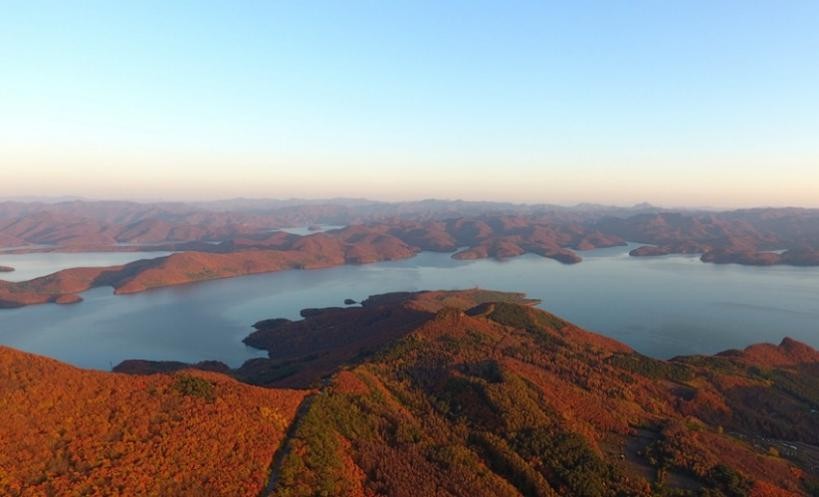In midsummer, the average temperature is 23 degrees Celsius in the Maple Valley in Huanren Manchu Autonomous County, Northeast China’s Liaoning Province. The air among the maple trees tastes clean, crisp and marketable.
Seven years ago, a scenic spot was built in a forest logging base in Huanren. The scenic spot, famous for its forest oxygen bar and maple spot, became a 4A level tourist attraction later.
China ranks attractions nationwide from 1A, the lowest level, to 5A, the highest, based on safety, cleanliness, sanitation and transportation.

Maple Valley in Huanren Manchu Autonomous County, Northeast China’s Liaoning Province. (Photo: official website of The Maple Valley Forest Park Tourism Company)
Up to 2019, this relatively new scenic spot had earned a cumulative income of more than 53 million yuan (about $7.6 million), benefiting more than 20 poorer villages in the county.
Some 667 hectares of forest were not felled as a result of the tourism project, according to Huanren county authorities.
The county maple tree forest boasts wild ginseng and fungus, offering other lucrative opportunities for a benign interaction between economic development and environmental protection.
Farm scenic spot
Eight years ago, the Maple Valley scenic spot was the Heping Forest Farm, an important county employer and logging base.
“Now my job is easy, and my income has doubled several times,” said Li Hongsheng, a 58-year-old forest guardian, who worked in the farm before.
Zhan Jundong, the head of the forest farm, noted that Huanren once had eight such state-owned lumber farms.
“Before the monthly income of employees was only a few hundred yuan,” Zhan said. “At the most difficult time, about 80 percent of workers’ families were in difficulties.”
In 2002, commercial logging of natural forests was halted in Huanren.
The Maple Valley Forest Park Tourism Company was formally established at the end of 2011. The park is controlled by the Heping Forest Farm with investment from seven other farms.
Construction of the scenic spot required planting trees, repairing roads and converting log yards into parking lots.
The park opened in September 2013.
“The year it opened, the revenue from the scenic spot reached 2 million yuan,” said Wang Shujie, deputy director of the Huanren county forestry bureau.
With national 4A-level recognition for the scenic spot, the revenue appears set to keep rising.

Huanren Manchu Autonomous County, Northeast China’s Liaoning Province. (Photo: Xinhua)
Village tourism
The lives of Heping villagers have undergone tremendous changes in the conversion to tourism.
Of 1,801 residents in 2019, 1,243 worked in tourism.
They have opened 63 guesthouse villas and per capita income has increased from 5,000 yuan in 2013 to 23,000 yuan. All the poor have lifted themselves out of extreme poverty.

A Heping Village villa (Photo: China Youth Daily)
The scenic area has more than 10 farmers’ stalls where vendors can sell their own produce and sideline products.
These stalls are free to operate for the registered poor and priority is given to hiring poorer households.
Maple Valley authorities have launched poverty alleviation cooperation with 23 “poor and weak” villages in 2019, explained Yuan Ye, deputy director of Huanren county poverty alleviation office.
The investment income of the villages reached 633,000 yuan, benefiting 419 poverty-stricken households with a total of 838 people, Yuan said.
“In 2020, five new towns will be added on the cooperation list of the Maple Valley, with a cumulative poverty alleviation fund of 21.4 million yuan and more than 1,000 households are expected to benefit.”
Eight percent of the scenic area’s stable income is distributed to towns and villages each year to subsidize poverty-stricken households who are unable to work, have no ability to develop industry, have serious diseases or have children attending colleges and universities.
No such household receives less than 1,000 yuan a year.
Forest plantation
Huanren suits ginseng, especially since the logging ban.
“The company was put into operation in 2018, and its cumulative sales have exceeded 100 million yuan already,” said Wang Xingren, executive deputy general manager of Huanren Longshen Health Pharmaceutical Company.
“The wholesale price of a 20-year-old undergrowth ginseng is 500 yuan. Older ginseng can even be worth tens of thousands of yuan.”
Ninety-nine percent of Yaoqianshu villagers grow ginseng and the average annual household income exceeds 100,000 yuan.
Other villagers who plant and harvest fungus, schisandra or hazelnuts have reportedly boosted their incomes ten times.
Dadianzi villager Dong Fujun quit logging for fungus.
"The fungus will be ordered as soon as it is dried, so there is no need to worry about not being sold," Dong said.
The annual output value of mountain ginseng is 2.1 billion yuan. There are more than 3,000 farmers who grow maple trees with an annual income of more than 10,000 yuan.
Five products including hickory oil are recognized as National Geographical Indication Products (NGIPS), a kind of indication that identifies particular goods as originating in a region, where a given quality, reputation or other characteristics of the goods is essentially attributable to the natural or human factors.
Lucid waters and lush mountains have brought sustainable growth to the people of Huanren.
(Translated by Zhu Naiqing, edited by Zhang Jian and Zhan Huilan)


